Mass Communication
Learning Unit’s Contents
Mass Communication Defined
Mass Communication will be the last of the communication contexts discussed in this course.
When we defined Mass Communication in the introduction of the course (learning module 1) we highlighted following characteristics:
- Mass Communication is mediated. The source of the message communicates through some electronic or print medium.
- The sensory input potential for receivers is more limited. Meaning that the receiver of messages can hardly give any feedback.
- Receivers of a mediated message have little or no control over its sources.
- The sources of mediated messages are known either in a limited way or not known at all, only imagined
- The source work through a complex organization. (as a Radio or TV broadcast corporation – or a newspaper editorial).
- The message represents the effort of many different people. (Just read the end credits the next time you watch a movie.)
1 – Mass- versus Telecommunication
Since both terms are frequently used as synonyms – incorrectly in some cases – it is important to know the different between Mass Communication and Telecommunication.
Both forms of Communication are mediated, meaning that a technological infrastructure is necessary.
The Greek work “TELOS” means “Distance”.
Telecommunication is any form of communication that uses technology to save a the physical distance between the sender and the receiver of the message.
Obviously all the examples of mass communication you can think of use technology to save the physical distance between sender and receiver of messages. Thus, Mass Communication is a term subordinated to Telecommunication. However, not every form of Telecommunication is Mass Communication. When you are using the cell phone, for instance, you are using a sophisticated technology to save the distance that physically separates you from the person you are calling. This communicative act is a form of interpersonal communication.
In the case of the mass-communication,
The message is directed to masses of people, and not to individuals or small groups.
2 – The Audience in Mass Communication
The audience in Mass-communication can be described using 4 adjectives:
LARGE (some events may gather vast audiences, millions of people around the world),
HETEROGENEUS (the viewers are totally different),
ANONYMUS, (no way to create face to face interaction), and
PASSIV, (The feedback potential of the audience in Mass Communication is very limited).
One of the problems of mediated communication is that the required technological infrastructure creates an abyss between the sender of messages and audience. The following graphic gives you an idea of the complexity of the media enterprise. It shows all the different media that belong to the same group: Time Warner.
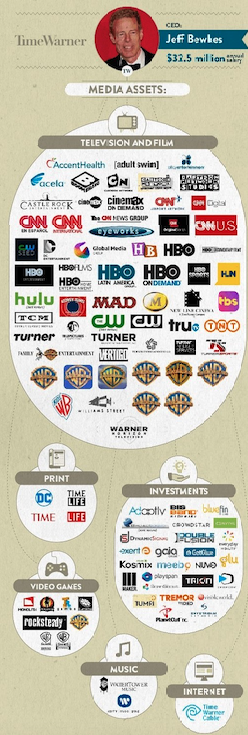
3- Functions of Mass Media
Denis McQuail states that the main function of Mass media is to help us satisfy some of our needs. The word “media”, by the way, is the plural form of “medium”, and thus, it will be used wit the corresponding verb conjugation (mass media are … instead of mass media is …) in this chapter.
3.1 Need for Information
The media have become the most important reference for us of what is going on in the world. And this apply not only for the parts of the planet we do not have access to, but also for place we are living in.
3.2 Need for Entertainment
Mass Media represent frequently a window to escape from problems – or to forget them.
We use them for relaxing and for action.
McQuail states that Media are also used for emotional or even sexual arousal.
3.2 Need for Integration, Social Interaction or Social Empathy
Through the Media, we get the sense of belonging.
The contents of the Media are also a basis for conversation and social interaction.
Sometimes, the Media become a substitute for real life companionships.
3.2 Need for Personal Identity
In the media we search for references in our life,
models we can associate with, or imitate.
We also look for opinions we can defend or attack, or even for stereotypes to organize the world outside our heads.
4 Uses and Gratifications Theory
According to this theory,
the main motivation to use the media is the gratification we get from them.
This is a rational model because it implies the free choice of the individual.
In the process of socialization, we learn the different Media, their characteristics and uses.
And then, in the adulthood, we consciously choose to use different Media according to our rational expectations,
meaning, the kind of gratifications we can get from them.
The audience, in this model, is not passive at all,
the individuals who form this audience are mature and independent.
They are also immune against the power of Mass-Media.
This rational model tends to play down the effects of the Mass-Media.
And this last point, the effects of mass media, leads us to our next learning unit.
Mass Media Effects – Classic Theories
When I discuss the topic Mass Media Effects, I like to recall the origin of the research in this field, how everything started.
And everything started the Halloween evening of 1938, one of the most interesting episodes in the U.S. history of the 20th Century.
That evening, Orson Welles directed a life radio broadcast program with the title: “The Invasion from Mars”. The fictional radio show was based on “The War of Worlds“, a popular science-fiction novel by H. G. Wells.
Welles’s program – and the novel – was about the invasion of the earth by inhabitants of the planet Mars. (You may know the last filmic version of this novel directed by Steven Spielberg starring Tom Cruise).
The amazing event of that Halloween evening of 1938 was that almost 6 million American citizens believed that America was actually being invaded by Martians. Many of them panicked and left their houses trying to escape from the invasion to who knows where.
The radio shock made Orson Welles famous overnight. He signed a contract with the film studio RKO and became one of the most relevant American filmmakers (two years after “The Ivasion from Mars”, he released “Citizen Kane”, which is regarded by many film critics as the best movie ever).
This episode, which belongs now to American Histor, opened the eyes of the Communication Researchers. If the people believe that they are being attacked by extraterrestrials, this was the starting thought, they will believe everything we tell them through the Mass-Media.
This is the reason why researchers started to investigate which are the actual effects of Mass-Media on individual and society.
Selective Exposure Theory
Ironically, the first outcomes of empirical Mass Media Research during the 1950ies seemed to deny any influence of Mass Media on individuals or society.
According to the findings of those pioneers in the field of mass communication, individuals expose themselves only to those messages that are in consonance with their previous opinions, while they tend to ignore every message that is in contradiction with their world of values and beliefs.
They called this phenomenon SELECTIVE EXPOSURE.
The selective exposure theory is based on Leon Festinger’s concept of “cognitive dissonance”. The individual, according to Festinger, needs to avoid ideas that are in dissonance to each other. When the individual becomes aware of this dissonance, one of the ideas needs to be rejected in order to keep the inner balance.
For instance, a convinced democrat voter may avoid negative messages about the democrat candidate (or positive ones about the republican one). Accepting those dissonant messages might force him/her to reconsider his/her own political standpoints.
The Selective Exposure theory minimizes the power of Mass Media.
The only possible effect would be reinforcing what we previously believed. If we avoid those messages that are in contradiction with our previous beliefs, media do not have the power to change our minds.
Gate-Keeping Effect
Although there is something true in this theory, it was also obvious that the Mass Media had an influence on our life and on our society.
Very soon, Kurt Lewin established the concept of GATE-KEEPING to describe the flow of information in mass communication.
In this context, a gatekeeper is any individual who has power over that flow of information, who can control what is going to be released to the public.
In mass communication we find whole networks of gatekeepers. Let’s say that you are working as a free lance PR writer. You produce a press release and send it to a newspaper. The assistant editor will first read your release. If this gatekeeper accepts it, it will go to the next step: the senior editor of this section of the newspaper. Still, whether the piece will be published or not, will be decided by the editor-in-chief. Whatever reaches the public needs to go through a series of filters. And of course, an important amount of information is filtered out in the process (for instance, only 20% of the press releases produced by PR departments and firms are finally published).
Agenda Setting Theory
Closely related to the Gate-Keeping theory – or as a consequence of this theory – the mass communication scholars Maxwell McCombs and Donald Shaw revealed in the 1970ies the so-called AGENDA-SETTING EFFECT OF MASS MEDIA
The agenda setting approach is a response to the selective exposure theory.
Even if the media cannot determine what we think because we tend to avoid those messages that are in contradiction with our beliefs, McCombs and Shaw proved that they can surely determine what we think about.
They select from the complex reality a couple of subjects.
And with this selection, they can determine what we are going to worry about, what we are going to talk and to discuss about, which topic we are going to have an opinion on. This is what we call news.
Whatever is not in the media will never get into our awareness. It simply does not exist for us. In this way, mass media shape how we perceive the reality.
Pseudo-Events
The media can set or build the public agenda not only selecting from the real world topics and issues.
The Historian Daniel Boorstin created the term PSEUDO-EVENT in his classic book “The Image” (1961) to refer to those stage events. Examples of pseudo-events are press conferences, personal appearances, awards ceremonies, electoral debates, or even the super-bowl. almost 70% of what is reported in the media is the result of any kind of pseudo-event.
According to Boorstin, the main characteristics of Pseudo-Events are:
- It is not spontaneous, but comes about because someone has planned, planted, or incited it. Typically, it is not a train wreck or an earthquake, but an interview.
- It is planted primarily (not always exclusively) for the immediate purpose of being reported or reproduced. Therefore, its occurrence is arranged for the convenience of the reporting or reproducing media. Its success is measured by how widely it is reported. Time relations in it are commonly fictitious or factitious; the announcement is given out in advance “for future release” and written as if the event had occurred in the past. The question, “Is it real?” is less important than, “Is it newsworthy?”
- Its relation to the underlying reality of the situation is ambiguous. Its interest arises largely from this very ambiguity. Concerning a pseudo-event the question, “What does it mean?” has a new dimension. While the news interest in a train wreck is in what happened and in the real consequences, the interest in an interview is always, in a sense, in whether it really happened and in what might have been the motives. Did the statement really mean what it said? Without some of this ambiguity a pseudo-event cannot be very interesting.
- Usually it is intended to be a self-fulfilling prophecy. The hotel’s thirtieth-anniversary celebration, by saying that the hotel is a distinguished institution, actually makes it one.
Daniel Boorstin’s book was prophetic. The author was able to foresee that pseudo-events will become increasingly relevant in the mass communication society. Nowadays almost 70 % of the news we get from the different media (newspapers, magazines, TV or radio stations) is the result of some kind of pseudo-event.
Boorstin also explained the reasons why pseudo-events are overshadowing spontaneous events in the media.
- Pseudo-events are more dramatic. A television debate between candidates can be planned to be more suspenseful (for example, by reserving questions which are then popped suddenly) than a casual encounter or consecutive formal speeches planned by each separately.
- Pseudo-events, being planned for dissemination, are easier to disseminate and to make vivid. Participants are selected for their newsworthy and dramatic interest.
- Pseudo-events can be repeated at will, and thus their impression can be re-enforced.
- Pseudo-events cost money to create; hence somebody has an interest in disseminating, magnifying, advertising, and extolling them as events worth watching or worth believing. They are therefore advertised in advance, and rerun in order to get money’s worth.
- Pseudo-events, are easy to understand. Being planned for intelligibility, are more intelligible and hence more reassuring. Even if we cannot discuss intelligently the qualifications of the candidates or the complicated issues, we can at least judge the effectiveness of a television performance. How comforting to have some political matter we can grasp!
- Pseudo-events are more sociable, more conversable, and more convenient to witness. Their occurrence is planned for our convenience. The Sunday newspaper appears when we have a lazy morning for it. Television programs appear when we are ready with our glass of beer. In the office the next morning Jack Paar’s (or any other star performer’s) regular late-night show at the usual hour will overshadow in conversation a casual event that suddenly came up and had to find its way into the news.
- Knowledge of pseudo-events–of what has been reported, or what has been staged, and how–becomes the test of being “informed.” News magazines provide us regularly with quiz questions concerning not what has happened but concerning “names m the news”–what has been reported in the news magazines.
- Finally, pseudo-events spawn other pseudo-events in geometric progression. They dominate our consciousness simply because there are more of them, and ever more.
Framing
Generally, the concept of framing is used in combination with the agenda setting effect of mass media.
Framing refers to the way we perceive the reality around us. We use pre-established cognitive structures in order to organize sensorial stimuli and the information we are exposed to. Those pre-existing cognitive structure, which Leon Festinger called schemata, are not neutral. They imply a judgment on people, situations, or actions. Such “frames” facilitate the immense task of making sense of the world.
When framing news, we are not only providing our target audience with information, but also giving them the necessary clues to interpret the events we are reporting. The capacity of framing issues gives media and journalists the power of determining (or at least influencing) how the audience will perceive those issues.
Example of framing: When reporting about an extramarital affair of one political candidate, you can use different frames to approach the issue: adultery, romantic love, sexual freedom. Every one of those frames will imply a different moral judgment of the action.
Social Learning Theory
Another important theoretical framework in the research of Mass-Media Effects is the so called SOCIAL LEARNING THEORY, developed by Albert Bandura and associates.
The main statement of this theory is that we learn how to act in private and public settings observing the behavior of the people in movies or TV.
The process is known as modeling (or imitation). Modeling goes throughout one’s lifetime, but it is especially important during the formative years of childhood.
Bandura et al. showed that, for instance, the more stars smoke on the screen, the more popular smoking became among the population.
It is interesting, in this regard, to compare the screen behavior of the 1940ies and 50ies on the screen (Humphrey Bogart is the best example) with the behavior of contemporary Hollywood icons.
Cultivation Effect
George Gerbner and associates discovered in the nineties the CULTIVATION EFFECT of mass media.
This theory goes a step forward regarding other theories.
It says that our perception of the reality is determined by our Media Use. The more we watch TV, The more we think that the reality is like what we see on the screen. Heavy Media users, for example, overrate the violence in our society, even if they never were victims of violence themselves. They think that the percentage of Doctors and Policemen is much bigger than in reality, because Doctors and Policemen are over-represented in TV and movies.
Or that there are much more cases of adultery than in reality.
One of the consequences of the cultivation effect of mass media is what Gerbner called “Mean World Syndrome”. Since bad news are overrepresented in the media, and since violence plays also a essential role in movies and TV shows, people tend to believe that the world is a much more violent and evil place to live than it is in reality.
Message Flow
In the last learning unit, we learned which are the effects of mass Media in the audience. In this one, we will discuss how those effects come about. This is what we called the message flow. Again, we will analyze some theoretical frames that try to find an answer to this question.
1 – Hypodermic Needle Model
Each audience member receives messages directly from the source of a given medium, like an injection.
The flow of communication is very simple. We consume the contents of the media, and these contents affect us directly. This was the
2 – Two-Step Flow of Communication (Lazarsfeld, P.)
Paul Lazarsfeld revealed the role of the informal opinion leaders in the process of mediated communication. Informal opinion leaders are those who do not have access to the media, but are influential in other circles of their lives, such as family, work, friends, etc.
Ideas and opinions flow from the mass media to the opinion leaders – and from these to the rest of the less active population.
Lazarsfeld also found that informal opinion leaders tend to consume more media that the average individual
3- Multiple Step Flow of Communication
This Theory is a development of the previous one. There are different levels of opinion leadership (Family, Work, Studies, friends, …). People who are opinion leaders in their families may adopt a rather passive role in the work environment.
And there are also Media that form the opinion of other media, opinion leadership among media. (The New York Times is more influential than The Hartford Courant, and The Hartford Courant more than The New Britain Herald).
Visual Communication
We are living in the AGE OF THE IMAGE.
The technologies of photographic reproduction radically changed the communication world in the last decades of the 19th Century.
Our conscious world, now,is a world of images.
Images might influence or even determine your values, your beliefs – and of course also your opinions.
You don’t need to read books about World War II or the Holocaust. Just a couple of minutes of documentary movie about the Nazi-Death-Camps might be powerful enough to influence your mind,
and decide your opinion and attitude about the subject.
Other images that have decided the values or beliefs of millions of people, are the Assassination of John F. Kennedy, the Tiananmen Square in Beijing, or, of course, the terrorist attack against the World Trade Center twin towers.
The mass media intensify the relevance of the image and the visual communication. It is therefore necessary to end this introduction to the world of communication analyzing the characteristics of visual communication.
1 – Icons
An Icon is something that looks like the thing it resembles.
And Iconicity is the ability of a visual message to evoke the recognition of the object or subject it resembles.
What do you see in the following picture?
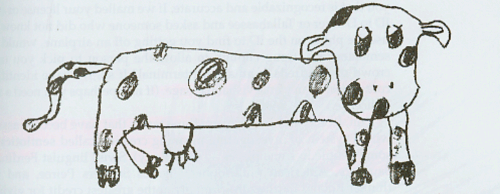
And in this one?
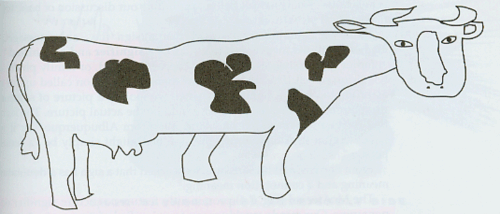
and what about the third one?
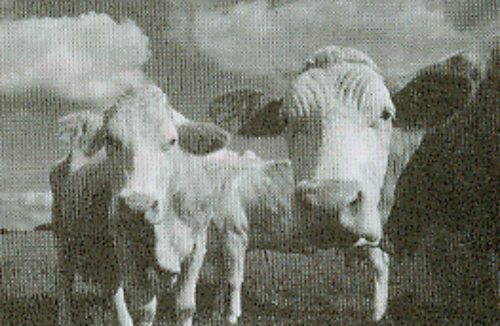
If you have answered “a cow” to the three questions, then you have not understood what an icon is.
The three images are “icons”, not cows, with different degrees of iconicity. They look more or less like the thing they resemble (a cow).
2 – Signs
In Semiotics, we define a SIGN as
any message or element within a message.
Every sign consists of two elements: the signifier and the signified.
The SIGNIFIER, in case of visual communication, is the physical image you observe (in visual rhetoric).
The SIGNIFIED is the mental connection called up for us as prompted by the signifier.
There are two types of signified:
DENOTATION:
The signified we have learned and that is most probably associated with the signifier
and
CONNOTATION:
subjective signified that depends on personal experience.
In this lecture, we will just focus on visual signs
3- Visual Signs
According to Charles S. Peirce, there are three basic categories of visual signs:
- Iconic Sign:
An image that looks like the thing or person it represents. - Indexical Sign:
A sign that some process or activity has taken place. - Symbolic Sign: An arbitrarily created sign.
Example of Iconic Sign:
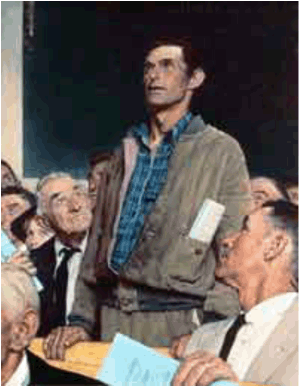
Examples of Indexical Signs:


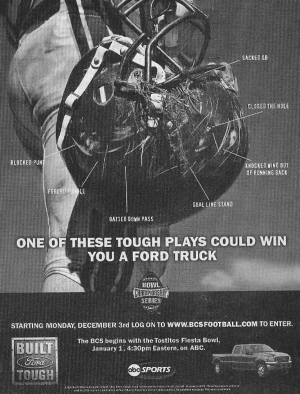
Examples of Symbolic Signs:


